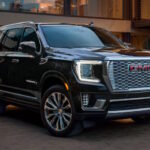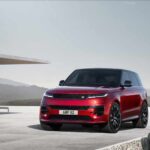What’s all this about Tiny Jeeps? There’s a movement toward sensible, super-useful Tiny Jeeps, but you don’t read much about them: We’re not supposed to call little off-roaders by the name “Jeep” without raising a cry from trademark lawyers at Fiat Chrysler Automobiles, Jeep’s current owners. We’re supposed to call them “subcompact crossover sport utilities,” which is a mouthful. One of the latest Tiny Jeeps was just introduced as the Eclipse Cross by Mitsubishi, which knows how to make these things. How? Mitsubishi manufactured Jeeps in 1947 for Japan’s Regional Forest Service and National Defense Force, under license from then-owner Willys-Overland Motors, the original creator of the Jeep.
The Eclipse Cross should be on sale by this March in the U.S. It is half-a-foot longer than the norm in the subcompact crossover class (you know, Tiny Jeep), but priced smack in the segment center starting at $23,295 plus $600 for four-wheel-drive. Leaders in this segment are the better-known Honda HR-V and the new Toyota C-HR, both smaller brothers of the stronger-selling CR-V and RAV4 compact crossover SUVs. Nissan’s Rogue topped this group’s sales for 2017 at more than 400,000, for the first time in the industry selling more than any sedan, such as perennial leaders Honda Accord and Toyota Camry. The difference in this new Mitsubishi, which shares a platform with shorter and longer versions called Outlander Sport and Outlander, is to whom the design is aimed: Driving fun devotees and four-wheel-drive fans. Not suburbanites, who buy a lot of these without the four-wheel-drive option or fun-to-drive capability.
The original CR-V and RAV4 started the Tiny Jeep trend in 1996, and Jeep executives were then forced into discussing the possibility of also making lightweight future car-based Jeeps that they called “soft-roaders”. Insiders tell us there was quite an internal corporate battle, but expanding the Jeep lineup to include car-based Cherokees and Renegades and Compasses has proven the best business case, and all models of these Tiny Jeeps (actual Jeep-trademarked vehicles) have versions tuned to survive California’s difficult Rubicon off-road trail. The good Jeep gear, however, adds $2,000 to their prices.
Tiny Jeeps don’t look like racers, but they act like them.
In 2014, Porsche’s Macan CUV (compact utility vehicle) with a 395-horsepower turbo V-6 model lapped the “Green Death”, slang for the north loop of the Nurburgring racetrack in Germany, mere seconds off the pace of the company’s legendary 911 sports coupe; The Macan will go 165 mph.
Nowhere near as fast, the Eclipse Cross is powered by a new turbo 1.5-liter direct-injected 154-hp four-cylinder, with most of its 184-lb. ft. of torque at a low 2,000 rpm, so it pulls uphills on freeways without straining. Tiny Jeeps give up less performance to cars than their bigger, heavier siblings; the Eclipse Cross weighs about 2,500 pounds, the same as a 1946 Jeep, and 1,000 pounds lighter than most passenger cars. They are nimble, responsive and one bonus with the Mitsubishi is its four-wheel-drive system, standard on 80 percent of trim levels, is tuned to help the vehicle corner on dry pavement as well as gravel and snow. This sensible performance makes us wonder what type of Tiny Jeep that Hummer would have offered if GM had kept the company alive following the recession in 2009. Picture a Chevy Trax with a gun rack.
The Eclipse Cross has been tuned to handle better on Mulholland Drive in the California coastal mountains than the de-contented mass-market versions sold by Honda, Toyota, Ford, and Nissan. Torque vectoring between all four wheels is the reason it’s fun, a product of electronics trying to make up for the Jeep’s ability to use complex mechanical differentials to ensure top rock-climbing ability.
Only the Jeep is available with a manual transmission, a nod toward hardcore drivers, and the rest of the segment favors compact and efficient continuously variable (CVT) automatics. The Eclipse Cross CVT, a Jatco unit shared with some Nissan models, features eight “speeds”, which are manually selected fixed ratios the use of which we found improve drivability at the expense of slightly lower fuel economy. You can learn to make this transmission work well on twisting roads (where Mazda’s sport-aimed CX-3 excels, for example) by using the shift lever or steering column-mounted paddle switches.
Where we drove.
Twisty roads plus towns with people who are hunker-down prepper types (What’s prepper mean? See “Lights Out: A Cyberattack, A Nation Unprepared, Surviving the Aftermath” by top newsman Ted Koppel) have always been drawn to the hills above Malibu beach on the California coast. We ran up the twisty Latigo Canyon road from Malibu, and when we reached Mulholland Drive we found the Rock Store, famous as a stop for hard-core motorcyclists for decades, where hundreds of vintage bikes, cruisers and customs, and Superbike World Championship look-alikes show up Sundays. Ed and Veronica Savko moved to Southern California from Pittsburgh, Pennsylvania after WWII, stumbled across a building made entirely out of volcanic rock, which had been a stagecoach stop in the 1910’s, and opened the Rock Store cafe in 1961.
Continue down Mulholland one mile to a tiny burg called Cornell, centered around The Old Place, an eat-what’s-served restaurant serving “a 32-ounce oak-grilled Old Place Cut sirloin bone” for $48. Started in 1970 by the “Runyon Clan”, refugees from New York’s coal industry, it has attracted “a collection of movie stars, tractor operators, outdoorsmen, artists and everyday folk mixed in the small space”, to escape the froufrou of Los Angeles’ “emerging art and film crowd,” according to the back of the menu. The Old Place does not have a freezer. It does make artisanal espressos in the back of an old farm truck.
Tiny Jeeps are good during social upheaval.
We love the good Tiny Jeeps, as much as we love the way the Tiny House movement helps rid us of property taxes and mortgage companies. Tiny Jeeps’ relatively low weight and small size means that when a political apocalypse comes, you can easily push it out of the paths of tanks and algorithm-summoned Ram 4500 Vulcan wreckers if you forget to pay a parking ticket.
This has happened: Argentinian Fernando Aguirre said that his Honda CR-V, in addition to good fuel economy and good ground clearance, shares enough parts with the globally ubiquitous Civic that it would be easy to find parts for cheap repairs during an economic crisis. Aguirre, author of “The Modern Survival Manual”, who survived Argentina’s governmental collapse in 2002 driving his CR-V noted that it being smaller than a Hummer or a more common American prepper’s full-size pickup, the CR-V was capable of squeezing through blocked highways and Buenos Aires alleyways where other vehicles got stuck. “For me, it’s not about off-road,” added Aguirre, who modified his CR-V with heavy plastic film inside its window glass so rocks and bricks wouldn’t shatter them. Another armageddon necessity: run-flat tires. In Argentina during the 2002 crisis, he said, if a tire blew out, there was a good chance it was caused by car-jackers.
“Sometimes smaller is better so you can squeeze in there and get away especially if there are obstacles in the road,” he said. Good fuel economy “means a lot when you are trying to get really far away.” He would, however, add a three-inch suspension lift and all-terrain tires to his CR-V should Argentina suffer another total governmental collapse.
High-virtue styling.
There is a wing on the back hatch of the Eclipse Cross. “We noted that the segment needed a styling change,” explained Mitsubishi Motors marketing director Francine Harsini. Her data shows the fastest growing markets of small SUVs–where almost all subcompact crossovers look like the new urban vehicular Mao uniform, or a “Look at me, I recycle, and I cast a small carbon footprint,”–seem to be the south and the coasts of the U.S., say Mitsubishi executives, exactly where global warming threatens to copy Atlantis. Correlation does not equal causation, we believe, so we have another theory: If you stripped all of the interior out of a Tiny Jeep, you would have a steel container that is larger than a two-person Assault 2 tent sold by The North Face. You will survive in the Eclipse Cross, and you will feel as mobile as humans can be on planet Earth.























